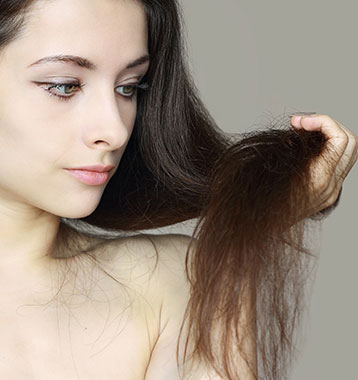Greasy hair
Greasy hair appears dirty, greasy, oily, shiny and often has an unpleasant odor.
Individuals who have greasy hair often also have other areas of the skin (nose, forehead, chin) that are quite greasy (called “seborrheic” skin).

Scientific collaboration between Professor Marco Toscani and Dr. Pasquale Fino, Chair of Plastic, Reconstructive and Aesthetic Surgery, Umberto I Health Center – “Sapienza” University of Rome.
Changes in the hair shaft lead to deterioration with the appearance of ruined or damaged hair.
In healthy hair, the cuticle is whole, with overlapping shingles. Hair with whole ends appears shiny, elastic and brushes easily.
In this case of brittle hair, the shingles of the cuticle are raised or in some cases absent. Hair appears coarse to the touch, dull, opaque, untameable, difficult to brush, with loss of color and a reduction of shininess.
In this type of damaged hair, the protein structure of keratin appears to be altered. The hair loses its amino acidic equilibrium, becoming gradually more delicate and less resistant to external aggressions. One of the possible causes is psycho-physical stress.
Use of an overly intense or hot hair dryer results in dryness and dehydration of the shaft. The hair becomes electrified. It ends up losing its hydro-equilibrium, with a subsequent reduction of diameter of the shaft.
Characterized by the presence of split ends. Hair appears dry with the presence of dry, discolored and damaged ends. In the case of some lengths, it may assume a particular “dovetail” form.
Trichoclasis, typical of fine, thin hair, causes very deep damage in the hair stem. The hair ends open up like a brush. The cause of trichoclasis is mineral deficiency.
Swelling of the cuticle and the cortex lead to a reduction and subsequent loss in elasticity and softness of the hair, making it untameable and difficult to brush. Off-the-shelf products with emollient and hydrating properties such as oil compresses, flaxseed and restructuring and regenerating masks are remedies and treatments used to cure brittle hair.
Greasy hair appears dirty, greasy, oily, shiny and often has an unpleasant odor.
Individuals who have greasy hair often also have other areas of the skin (nose, forehead, chin) that are quite greasy (called “seborrheic” skin).
Female hair loss is a common form of non-scarring hair loss, characterized by the progressive loss of hair in the forehead and crown regions, resulting in visible thinning. Unlike male hair loss, female hair loss in the affected areas is usually incomplete and the occipital area is generally spared.
La psoriasi è una frequente dermatosi cronica eritemo-squamosa con squama tipica (psoriasica), circoscritta o diffusa.
La psoriasi è un problema del cuoio capelluto non annoverata tra le cause che comportano la caduta dei capelli.
Excess sweat production on the entire surface of the body or just in some areas (especially the scalp, palms of the hands, soles of the feet) is called hyperhidrosis.
Some of the causes that may lead to temporary hyperhidrosis are physical hyperactivity, fevers, saunas, vomiting and dysentery. Causes that may instead lead to a repeated state of hyperhidrosis are hyperthyroidism, hypoglycemia and alcoholism
Dandruff is a scalp condition that usually arises between the ages of 10 and 25. It may improve between the ages of 45 and 55 or may continue during old age.
Its cause is a result of an accelerated turnover of epidermal cells, which following an increase in migration speed, are unable to reach complete maturity before detaching. Whitish-yellow flakes (masses of corneum cells) form and detach, gathering in patches or often spreading evenly across the scalp.
A shedding of hair is considered physiologically normal when hair loss is limited to around one hundred hairs per day. During an individual’s life hair grows, falls out and regrows around twenty times. Each cycle, especially for females, may last up to six years and if hair loss is found within this time frame, it is considered absolutely physiological.
Let our experts find the best solution for you.
Book a consultation with our experts. Find out more about CRLAB solutions.
Hair loss solutions for you. CRLAB, specialists in the well-being of your hair and scalp.